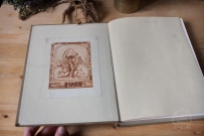This book caught my attention a few weeks ago: it was on display in the window of an antiquarian bookshop in Dresden and I swore to myself, to return and I’d buy it. So I did.
The book is from 1926, published by Schwarzeck-Verlag Dresden. It contains information and references to herbals from the 15th century, which – thanks to the invention of letterpress printing – were for the first time available to a larger audience, especially since they were written not in Latin but in German language, so that common people could understand and use them. These herbals were richly illustrated with surprisingly accurate woodcuts depicting the plants. Both pharmacology and botany developed quickly during this time. Soon followed similar herbals in Belgium, Italy and England.
The first chapter gives an introduction to these early herbals, their authors and illustrators. Mentioned are among others: Conrad von Megenberg, Otto Brunfels (botanist and illustrator), Leonhart Fuchs, Hieronymus Bock, Petrus Andreas Mathiolus, Konrad Gesner, Tabernaemontanus. Publishing a book was not an easy endeavor at a time, when there were no laws yet on coyprights. Unauthorized reprints occurred within the same year as the original and neither the original publisher nor author could do anything about it. (Sounds familiar in times of the internet, doesn’t it?) In addition, there was fierce competition among publishers and prices were dumped, once a larger number of a similar book was available… The authors describe all of this quite vividly and so this short discourse, on the first herbals ever printed, is a pleasant read, spiced with examples and quotes from these very first herbals. Simultaneously we learn how the first volumes on botany and pharmacognosy came into being.
I cannot go into detail on each chapter. Instead I list the translated index for reference:
- The Herbals of the Middle Ages
- The Doctrine of Signatures
- The art of distillation
- The spice wars
- The cultivation of drugs in Germany
- The China-Bark
- The Liquorice
- The tropein-containing Nightshades
- The Strophanthus
- The noxious and innoxious types of Strychnos
- The Elder
- The Indian Hemp (Cannabis indica)
- The Yohimbe bark
- The Guajacum tree
- The Sarsaparilla root
- The Shepherd’s Purse
- The Rhubarb
- The Aconite
- The Opium
- The Cantharides
There are altogether 272 pages. Whenever I skim through, I find something new and interesting, which I have not read elsewhere. This book contains plenty of interdisciplinary references and I am glad to have bought it.













Leave a comment